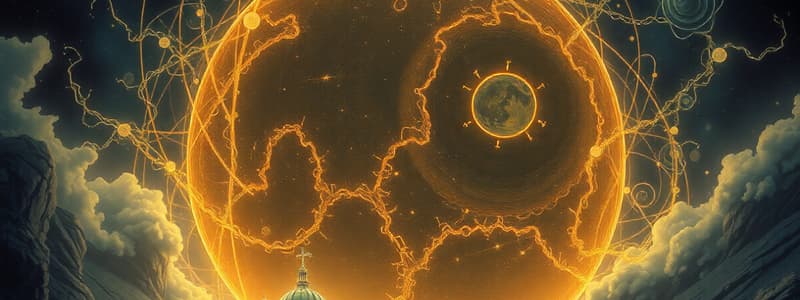Podcast
Questions and Answers
What is the unit equivalent to 1 Joule?
What is the unit equivalent to 1 Joule?
- 1 kg m2/s (correct)
- 1 Calorie
- 1 kg m/s2
- 1 N m (correct)
Which form of energy is defined as the potential to do work?
Which form of energy is defined as the potential to do work?
- Thermal Energy
- Kinetic Energy
- Internal Energy
- Potential Energy (correct)
What describes internal energy in a substance?
What describes internal energy in a substance?
- Energy of chemical bonds
- Energy stored in a gravitational field
- Energy of motion
- Total kinetic energy from random molecular motion (correct)
How is temperature related to molecular motion?
How is temperature related to molecular motion?
Which of the following statements about calories is correct?
Which of the following statements about calories is correct?
What atmospheric composition was predominant during the Archean era?
What atmospheric composition was predominant during the Archean era?
What process describes the dissolution of CO2 in water to form carbonic acid?
What process describes the dissolution of CO2 in water to form carbonic acid?
Why did oxygen levels not build up significantly before 2.3 Ga?
Why did oxygen levels not build up significantly before 2.3 Ga?
What is the term used for the rate at which carbon is being transferred from one reservoir to another?
What is the term used for the rate at which carbon is being transferred from one reservoir to another?
Which of the following is considered an anthropogenic source of carbon?
Which of the following is considered an anthropogenic source of carbon?
What event marked a dramatic increase in oxygen levels around 2.4-2.1 Ga?
What event marked a dramatic increase in oxygen levels around 2.4-2.1 Ga?
How much carbon is stored in the atmosphere, according to the data?
How much carbon is stored in the atmosphere, according to the data?
How was CO2 primarily removed from the atmosphere during the Archean?
How was CO2 primarily removed from the atmosphere during the Archean?
Which process dominates the carbon exchange cycle between land and atmosphere?
Which process dominates the carbon exchange cycle between land and atmosphere?
What does the term 'Net Flux' refer to in the context of carbon reservoirs?
What does the term 'Net Flux' refer to in the context of carbon reservoirs?
What is the equivalent of 1 GtCO2 in GtC according to the conversion factor provided?
What is the equivalent of 1 GtCO2 in GtC according to the conversion factor provided?
How does carbon move from land to the ocean?
How does carbon move from land to the ocean?
What is the measurement unit commonly used for flux in carbon cycling?
What is the measurement unit commonly used for flux in carbon cycling?
What does the First Law of Thermodynamics state?
What does the First Law of Thermodynamics state?
What is the formula for calculating the change in internal energy?
What is the formula for calculating the change in internal energy?
Why does beach sand get hotter than water on a sunny day?
Why does beach sand get hotter than water on a sunny day?
How is temperature related to internal energy?
How is temperature related to internal energy?
What best describes the concept of energy conservation?
What best describes the concept of energy conservation?
What primarily causes cold air to be trapped near the surface on cold, clear nights?
What primarily causes cold air to be trapped near the surface on cold, clear nights?
What is the primary method of heat transfer associated with hot air rising and cold air sinking?
What is the primary method of heat transfer associated with hot air rising and cold air sinking?
Which of the following scenarios describes advection?
Which of the following scenarios describes advection?
What effect does the latent heat of vaporization have on the environment?
What effect does the latent heat of vaporization have on the environment?
How much latent heat is required for water to change from liquid to vapor?
How much latent heat is required for water to change from liquid to vapor?
When does convection not occur in the atmosphere?
When does convection not occur in the atmosphere?
What is the relationship between latent heat and phase changes of water?
What is the relationship between latent heat and phase changes of water?
What role does latent heat play in evaporation?
What role does latent heat play in evaporation?
Flashcards are hidden until you start studying
Study Notes
Earth's Mantle and Atmosphere
- Early Earth's mantle likely had lower oxidation levels, resulting in more abundant H2 and CO.
- The Archean atmosphere (4.0 – 2.5 Ga) built upon conditions at the end of the Hadean; significant atmospheric factors included volcanic activity.
- Archean atmosphere composition:
- CO2 & CO: ~80%
- H2O: ~10%
- N2: ~10%
- The high concentration of CO2 resulted in surface temperatures reaching approximately 85°C.
Carbon Dioxide Changes
- Chemical weathering processes led to CO2 dissolving in water, forming carbonic acid, which reacted with silicate rocks.
- CO2 is transported to oceans, utilized by plankton, ultimately contributing to sedimentary rock formation.
- Plate tectonics recycle carbonates back into Earth's mantle, influencing carbon levels.
Oxygen Levels and the Great Oxidation Event
- Pre-2.5 Ga, atmospheric oxygen levels were less than 0.1%.
- A significant increase in oxygen occurred around 2.4-2.1 Ga, termed the "Great Oxidation Event."
- Oxygen accumulation was hindered by processes like mineral oxidation and biological activity.
Carbon Cycle Fundamentals
- Earth is a closed system for carbon, with no external transport; its carbon budget can be expressed in reservoirs and fluxes.
- Carbon reservoirs:
- Atmosphere: 589 GtC
- Ocean: 50,000 GtC
- Soils/Veg: 2,500 GtC
- Permafrost: 1,700 GtC
- Fossil Fuels: 1,700 GtC
- Carbon fluxes result from photosynthesis, respiration, and physical processes between atmosphere, ocean, and land.
Forms of Energy
- Potential energy is defined as the capability to perform work.
- Kinetic energy refers to energy associated with motion.
- Internal energy is linked to the random motion of atoms and molecules; it correlates with temperature.
Temperature and Internal Energy
- Temperature gauges the average kinetic energy of molecules; higher speeds indicate higher temperatures.
- Internal energy differs from temperature—Lake Mendota and hot coffee may exhibit different internal energy levels despite temperature readings.
Thermodynamics and Energy Conservation
- The First Law of Thermodynamics states energy cannot be created or destroyed, only transformed.
- Application of the law: Energy changes in internal energy are linked to heat added or work done by a system.
Heat Transfer Mechanisms
- Convection involves heat transfer through fluid motion; stable situations hinder convection.
- Advection describes heat transfer horizontally within fluids.
Latent Heat Concept
- Latent heat signifies the heat required for a substance to change phases.
- Latent heat of vaporization for water: 2.25 x 10^6 J/kg; latent heat of fusion: 3.34 x 10^5 J/kg.
- Phase changes of water, such as evaporation, consume energy from the environment, altering the internal energy balance.
Studying That Suits You
Use AI to generate personalized quizzes and flashcards to suit your learning preferences.




